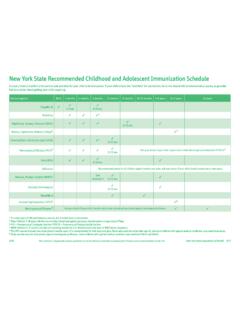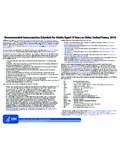Transcription of Table 2: Summary of WHO Position Papers - Recommended ...
1 (updated September 2020). Table 2: Summary of WHO Position Papers - Recommended Routine Immunizations for children Doses in Interval Between Doses Antigen Age of 1st Dose Primary Booster Dose Considerations (see footnotes for details). Series 1st to 2nd 2nd to 3rd 3rd to 4th Recommendations for all children Birth dose and HIV; Universal vs selective BCG 1 As soon as possible after birth 1 vaccination; Co-administration; Vaccination of older age groups; Pregnancy As soon as possible after birth 4 weeks (min) with 4 weeks (min) with Option 1 3 Premature and low birth weight (<24h) DTPCV1 DTPCV2. Hepatitis B 2 Co-administration and combination vaccine As soon as possible after birth 4 weeks (min) with 4 weeks (min) with 4 weeks (min),with High risk groups Option 2 4.
2 (<24h) DTPCV1 DTPCV2 DTPCV3. 4. (IPV dose to be 6 weeks 4 weeks (min) with 4 weeks (min) with bOPV + IPV given with bOPV. (see footnote for birth dose) DTPCV2 DTPCV3 bOPV birth dose dose from 14. weeks) Transmission and importation risk criteria Polio 3. IPV / bOPV 1-2 IPV. 8 weeks (IPV 1st) 4-8 weeks 4-8 weeks 4-8 weeks Sequential 2 bOPV. IPV booster needed for early schedule ( IPV 8 weeks 3 4-8 weeks 4-8 weeks (see footnote). first dose given <8 weeks). 3 Boosters 12-23 months (DTP- containing vaccine);. 4 weeks (min) - 8 Delayed/ interrupted schedule DTP-containing vaccine 4 6 weeks (min) 3 4 weeks (min) - 8 weeks 4-7 years (Td/DT. weeks Combination vaccine; Maternal immunization containing vaccine), see footnotes; and 9-15 yrs (Td).
3 4 weeks (min) with 4 weeks (min) with Single dose if >12 months of age Haemophilus Option 1 3 (see footnote). 6 weeks (min) DTPCV2 DTPCV3 Not Recommended for children > 5 yrs influenzae type 59 months (max) Delayed/ interrupted schedule b5 Option 2 2-3. 8 weeks (min) if only 2 doses 4 weeks (min) if 3 At least 6 months 4 weeks (min) if 3 doses doses (min) after last dose Co-administration and combination vaccine Option 1. 6 weeks (min) 3 4 weeks (min) 4 weeks 3p+0 schedule options Pneumococcal Vaccine options (Conjugate) 6. Option 2 HIV+ and preterm neonate booster 6 weeks (min) 2 8 weeks (min) 9-18 months 2p+1. 2 or 3 For three dose series 4 weeks (min) with Vaccine Options Rotavirus 7 6 weeks (min) with DTP1 depending on 4 week (min) with DTPCV2 Not Recommended if >24 months old product DTPCV3.
4 9 or 12 months 4 weeks (min) Combination vaccine; HIV early vaccination;. Measles 8 2. (6 months min, see footnote) (see footnote) Pregnancy Achieve and sustain 80% coverage 9 or 12 months with measles Rubella 9 1 Co-administration and combination vaccine;. containing vaccine Pregnancy Target 9-14 year old girls; Multi-age cohort As soon as possible from 9. 6 months (min 5 vaccination; Pregnancy HPV 10 years of age 2. months) Older age 15 years 3 doses (females only). HIV and immunocompromised Refer to for Table & Position paper updates. This Table summarizes the WHO vaccination recommendations for ages/intervals cited are for the development of country specific schedules and are not for health workers. National schedules should be based on local epidemiologic, programmatic, resource & policy considerations.
5 While vaccines are universally Recommended , some children may have contraindications to particular vaccines. / 11. (updated September Table 2: Summary of WHO Position Papers - Recommended Routine Immunizations for children 2020). Doses in Interval Between Doses Antigen Age of 1st Dose Primary Booster Dose Considerations (see footnotes for details). Series 1st to 2nd 2 nd to 3 rd 3. rd to 4 th Recommendations for children residing in certain regions Inactivated 2. Vero cell- 6 month 4 weeks (generally). generally derived Japanese Vaccine options and manufacturer's Live Encephalitis 11 8 months 1 recommendations; Pregnancy;. attentuated Immunocompromised Live 9 months 1. recombinant 9-12 months with measles Yellow Fever 12 1. containing vaccine 1 yr FSME-Immun and 1-3 months FSME-Immun and 5-12 months FSME-Immun At least 1 Definition of high-risk Encepur Encepur and Encepur Tick-Borne Encephalitis 13 3 every 3 years Vaccine options 3 yrs TBE_Moscow and 1-7 months TBE-Moscow and 12 months TBE-Moscow and (see notes) Timing of booster EnceVir EnceVir EnceVir Recommendations for children in some high-risk populations TCV (Typbar) >6 months 1 Definition High Risk; Vaccine options Vi PS 2 years (min) 1 Every 3 years Definition of high risk Typhoid 14.
6 Capsules 5 years (min) (see 3 or 4 (see Ty21a 1 day 1 day 1 day Every 3-7 years Definition of high risk footnote) footnote). Dukoral (WC- 3 (2-5 years) 7 days (min) < 6 weeks 7 days (min) < 6 weeks Every 6 months 2 years (min). rBS) 2 ( 6 years) (max) (max) Every 2 years Minimum age Cholera 15 Shanchol, Definition of high risk Euvchol and 1 year (min) 2 14 days After 2 years mORCVAX. Definition of high risk; Vaccine MenA. 9-18 months (5 g) 1 options; 2 doses if < 9 months with conjugate 8 week interval 2-11 months 2 8 weeks After 1 year Meningococcal 16 MenC Definition of high risk; Vaccine conjugate 12 months 1 options Quadrivalent 9-23 months 2 12 weeks Definition of high risk; Vaccine conjugate 2 years 1 options Level of endemicity; Vaccine Hepatitis A 17 1 year At least 1 options; Definition of high risk groups Rabies 18 As required 2 7 days (see footnote) PrEP vs PEP.
7 Definition of high risk Dengue (CYD-TDV) 19 9 years (min) 3 6 months 6 months Pre-vaccination screening Recommendations for children receiving vaccinations from immunization programmes with certain characteristics 12-18 months with measles 1 month (min) to school Coverage criteria > 80%;. Mumps 20 2. containing vaccine entry Combination vaccine Priority risk groups, especially Revaccinate Seasonal influenza (inactivated 2 ( <9 years) pregnant women 6 months (min) 4 weeks annually: 1 dose only tri- and qudri-valent) 21 1 ( 9 years) Lower dosage for children 6-35. (see footnotes). months 4 weeks to 3 months Achieve & sustain 80% coverage Varicella22 12-18 months 1-2 per manufacturer Pregnancy recommendations Co-admin with other live vaccines / 11.
8 Summary Table 2 - Notes Moderate-to-late preterm infants (gestational age > 31 weeks) and low birth weight infants (<. 2500 g) who are healthy and clinically stable can receive BCG vaccination at birth, or at the Refer to for the most recent latest, upon discharge. version of the tables and Position Papers . The attached Table summarizes the recommendations for vaccine administration found in the 2. Hepatitis B. WHO Position Papers which are published in the Weekly Epidemiological Review. Its purpose is to assist planners to develop an appropriate immunization schedule . Health care workers should Position paper reference: Weekly Epid. Record (2017, 92:369-392) [pdf ]. refer to their national immunization schedules. While vaccines are universally Recommended , Hepatitis B vaccination is Recommended for all children worldwide.
9 Reaching all children with some children may have contraindications to particular vaccines. at least 3 doses of hepatitis B vaccine should be the standard for all national immunization Vaccines can generally be co-administered ( more than one vaccine given at different programmes. Since perinatal or early postnatal transmission is the most important source of sites during the same visit). Recommendations that explicitly endorse co-administration are chronic HBV infection globally, all infants (including low birth weight and premature infants). indicated in the Table , however, lack of an explicit co-administration recommendation does should receive their first dose of hepatitis B vaccine as soon as possible after birth, ideally not imply that the vaccine cannot be co-administered; further, there are no recommendations within 24 hours.
10 Against co-administration. The birth dose should be followed by 2 or 3 additional doses to complete the primary series. Doses administered by campaign may or may not contribute to a child's routine immunization Both of the following options are considered appropriate: (i) a 3-dose schedule with the first schedule depending on type and purpose of campaign ( supplemental versus routine/pulse dose (monovalent) being given at birth and the second and third (monovalent or as part of campaign for access reasons). a combined vaccine) given at the same time as the first and third doses of DTP-containing vaccine; or (ii) 4 doses, where a monovalent birth dose is followed by 3 (monovalent or For some antigens, recommendations for the age of initiation of primary immunization series combined vaccine) doses, usually given with other routine infant vaccines; the additional dose and/or booster doses are not available.















